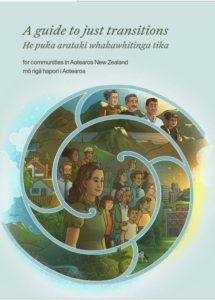A guide to just transitions

It has been a year since the publication of “A guide to just transitions | He puka arataki whakawhitinga tika“. The guide aims to assist communities, regions and sectors in navigating periods of disruption and achieving fair outcomes. Reflecting on the journey of developing the guide, I am reminded of the teamwork and dedication of the large cast of authors and practitioners involved in its creation. The development of this guide demonstrates the power of collaboration. Our team, brought together by Motu Research, consisted of diverse researchers and practitioners, each bringing unique perspectives and expertise to create a practical and inclusive resource to help communities effectively manage their transitions.
Just transitions are not only about sustainability, but also about making our systems inclusive, fair, and equitable. Today we face various challenges such as climate change, economic instability, and social inequalities, and we need responses that promote environmental sustainability, social equity, and economic development for all. This guide is designed to assist communities in developing visions and leadership to tackle these challenges together. This does not mean that communities should act alone. Making progress usually requires partnership, support and resources from government, business sectors, and others.
The guide is organised into five key chapters: Foundations, Connecting, Planning, Acting, and Adapting. Each chapter offers practical steps and insights to help communities navigate their unique transition journeys. For example, the Foundations chapter highlights the importance of understanding just transitions and the significance of Te Tiriti o Waitangi and Māori values in the Aotearoa New Zealand context. Subsequent chapters explore relationship building, planning, taking action, and adapting to changes:
- Connecting: This chapter focuses on building relationships and collaboration. It covers how to develop a leadership group, facilitate discussions, and build community support for transition initiatives.
- Planning: This section guides communities on designing inclusive transition processes. It includes understanding the system, developing a shared vision and values, and communicating effectively with stakeholders.
- Acting: Here, the guide provides insights on making collective decisions, considering various options, designing and implementing solutions, and resourcing the change processes. It emphasises the importance of coordinated actions to achieve meaningful outcomes.
- Adapting: This chapter encourages communities to be agile and adaptive. It discusses monitoring progress, evaluating and improving strategies, and knowing when to end or renew the transition efforts based on evolving circumstances.
To illustrate the principles and processes outlined in the guide, the report includes several case studies from different parts of Aotearoa New Zealand. These stories showcase successful community-led initiatives that embody the spirit of just transitions. From Ngāti Manu’s work to restore ecological and social well-being in the Kāretu Valley to the transformative efforts of the South Dunedin Community Network, these examples provide inspiration and practical lessons for others. Although the guide is designed with Aotearoa New Zealand in mind, the messages and principles should resonate in a much wider context. The challenges of ensuring fair and inclusive transitions are universal, and the approaches outlined in the guide can be adapted to various settings around the world.
Sometimes people, especially policymakers, might be unsure about the meaning of the term “just transition”. However, it is important to understand that just transitions are essentially about involving everyone, working together, and making decisions in an inclusive way. As the Center for Strategic and International Studies remind us, principles of just transitions closely align with effective community engagement and collaborative planning. By focusing on inclusivity, fairness, and having a shared vision, we can create processes that strive to take into account the needs and aspirations of all parties involved.
As we move forward, the principles of just transitions are more important than ever. Many of today’s challenges are complex and require collective action and creative solutions. This guide is one of many contributions from dedicated individuals and organisations. By continuing to collaborate, share knowledge, and support each other, we can work towards a fairer and more sustainable future.
Additional information can be found from the related LfS pages – Guides to help initiate and manage multi-stakeholder processes, Cross-sector partnerships and collaborations, and Facilitation – guides, tools and techniques. For those interested in learning more about the guide – A guide to just transitions | He puka arataki whakawhitinga tika – it is available online.
An independent systems scientist, action research practitioner and evaluator, with 30 years of experience in sustainable development and natural resource management. He is particularly interested in the development of planning, monitoring and evaluation tools that are outcome focused, and contribute towards efforts that foster social learning, sustainable development and adaptive management.

Leave a Reply